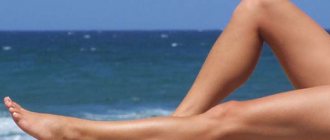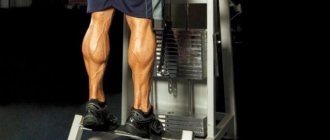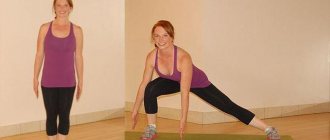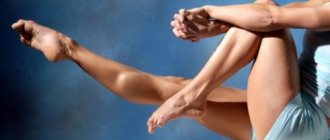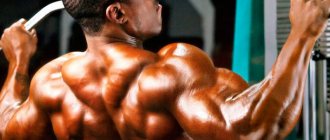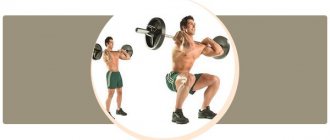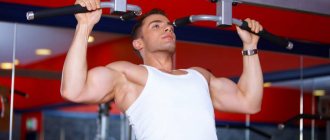Leg training is often limited to working on the roundness of the buttocks for female audiences. Male athletes also pay little attention to the lower legs. However, the attractiveness of the buttocks and the height of their landing depend on how the muscles of the lower leg and soleus are developed. In addition, a trained lower leg means stability in performing power loads, bench presses and the development of balance. Seated calf raises are a simple exercise that specifically targets the soleus muscle (the one under the calf muscles). It is responsible for the attractive relief and volume of the lower leg. Let's consider how this exercise is useful for athletes, carefully study the technique of performing the exercise and other features of the training.
Benefits and features of the exercise
Seated calf raises allow you to completely isolate the soleus muscle. It is located directly under the calf. Its development strengthens the calf muscles, helps increase their size and create an attractive shape. The exercise has a number of advantages:
- Increases strength indicators.
- Allows you to increase your jump height.
- Provides stability during barbell squats.
- Has a positive effect on the quality of running and its performance.
- Helps achieve good results in football and tennis.
- Improves body balance and helps develop balance.
- Has a positive effect on the ability to perform other exercises on one leg.
- Has a preventive effect. If the correct technique is followed, it helps prevent Achilles tendonitis.
How to do lifts correctly so as not to harm your health?
The technique for performing leg raises in a sitting position is as follows. Initial position:
the athlete sits on a bench or on the floor. It is better to lay a soft rug on the floor first to avoid injury to the tailbone or discomfort.
When performing leg lifts, it is better to keep your knees bent. This will prevent pain in the knee joints and also help maintain balance. The legs are raised throughout the entire exercise and do not touch the floor. The body is tilted 45 degrees, the arms are fixed behind the bench or on the floor.
As you exhale, the athlete pulls his legs to his chest and raises his torso, as if folding. The second name of this exercise is “fold”. After a short fixation, we move to the starting position.
Before you start training, check out a few tips from experts:
- The body and knees should always move towards each other.
- If there are no problems with the knee joints, then it is better to straighten your legs completely and tilt your torso as far back as possible.
- We don't touch the floor with our feet. It is especially important not to throw your legs.
Execution technique
Performing calf raises while sitting in a machine, despite their simplicity, requires strict adherence to a certain technique. Let's look at the sequence of actions step by step:
- Preparing the simulator. At this step, you need to select the working weight and install the weight.
- We sit down in the exercise machine, place our knees behind the bolsters (we adjust the height in advance).
- We take the handrails with our hands and place our feet on the edge of the lower platform of the simulator.
- During the exercise, your back should be straight and your head raised up.
- Raising your knees, remove the clamp holding the simulator.
- As you inhale, slowly lower your heels as far as possible. At the same time, bend your ankles as much as necessary to fully stretch the calf muscle.
- As you exhale, raise your heels as high as possible, like a “ballerina.” We linger in this position for several counts, feeling the muscle contraction.
Will the results obtained while performing calf raises in a machine both sitting and standing be equivalent? Definitely not. These are two different exercises. Raising your toes while standing in a machine is a completely different vector of load on the lower leg muscles. With its help, the calf muscle is perfectly worked out, while when performing seated lifts, the maximum load falls on the soleus muscle. Only by combining sitting and standing lifts can you achieve the desired volume and relief of the lower leg muscles.
The effectiveness of the sitting calf raise exercise depends on two factors. More details in the table.
| Efficiency parameter | Description |
| Range of ankle motion | You can increase the range of motion by placing a barbell plate or any platform under your toes. This will allow you to lower your heels as low as possible, increase muscle stretching and allow you to increase the load. |
| Working weight | The choice of weight should be such that it can be used to perform at least 10-12 repetitions of the exercise |
Just because you don't have access to a dedicated seated calf raise machine doesn't mean you shouldn't be able to effectively train your lower legs. Alternative variations of the exercise are possible with both a barbell and dumbbells.
Seated calf raises with a barbell are performed using the same technique as the exercise in the simulator. A certain inconvenience of this method of ankle training is the difficulty of holding a heavy barbell on the hips. However, the effectiveness of the exercise can be increased by using toe stands. In addition to the barbell, you can use any other weight: dumbbells, discs. The maximum result will be achieved by combined training of the lower leg muscles, which includes standing calf raises with a barbell and sitting.
Seated calf raises (seated calf raises)
Seated calf raises work the soleus muscle (the side of your calves). This isolation exercise swells the sides of your calves. Seated calf raises push the soleus muscle, located under the gastrocnemius, to the outside of the back of the lower leg. The more developed the soleus muscle, the more voluminous and muscular the lateral part of the lower leg looks.
Technique
Sit in a seated calf raise machine. Raise the bolsters and place the balls of your feet on the footrest so that your heels hang freely over the edge. The feet should be parallel to each other. Move forward in your seat—the bolsters should rest squarely on the bottom of your quadriceps. Straighten your torso.
Take a deep breath and, holding your breath, stand on your toes and lift your heels as high as possible.
At the top point, pause for 2-3 seconds and strain the soleus muscle, located under the calf, as hard as you can. Exhale and smoothly lower your heels as low as possible.
As soon as you feel that your calves are well stretched, immediately begin raising onto your toes.
For better stability, hold your hands on the edges of the seat or on the handles on the frame to which the bolsters are attached.
Adviсe
To thoroughly reach both sides of the soleus muscle (lateral and internal), be sure to take a long pause at the top point (for 2-3 seconds, no less).
Be sure to bend and extend the ankle joint to its full amplitude. Try to raise your heels as high as possible and lower them as low as possible. This improves the flexibility of the ankle joint and the elasticity of its ligaments, which will later protect you from injury during aerobic exercise.
If there is no machine for sitting calf raises, the exercise can be performed on a regular bench, placing the balls of your feet on a block at least 10 cm high - the main thing is that you can fully straighten the ankle joint without touching your heels to the floor. As a load, place a heavy barbell plate on your hips.
Considering that the exercise involves flexion of the knee joint, the lion's share of the load falls on the soleus muscle (and not on the gastrocnemius, as during standing calf raises). Keep in mind, the soleus is much more durable than the gastrocnemius, perhaps the toughest muscle in the body. Therefore, you will have to work hard and perform many more repetitions than standing calf raises to push your soleus to failure.
To give your shins a more impressive rear appearance, perform the exercise with the toes of your sneakers turned inward. In this case, you specifically bomb the internal bundle of the soleus muscle, which “pushes out” the internal head of the gastrocnemius muscle. As a result, it takes on a distinct, sharp shape that immediately emphasizes the massiveness of the calves when viewed from behind.
To focus the load on the lateral soleus (which visually increases the thickness of the calf when looking at the leg from the side), practice the exercise with the toes of your sneakers turned outward. Be sure to unlace your sneakers or change into sneakers, otherwise it will be uncomfortable for you to straighten/bend the ankle joint.
Application
To whom: Everyone, from beginner to master.
When: At the end of a calf workout. Before seated calf raises, perform standing calf raises or on a leg press machine.
How much: 3-4 sets of 12-20 repetitions.
Sport
While the gastrocnemius muscle is characterized by extraordinary strength and power, the soleus is characterized by amazing endurance. It is thanks to it that you can run a marathon or play an entire half of football. The more resilient this muscle is, the longer you can stay on your feet without rest and the longer the distance you will cover.
Load by muscle group
You can modify the calf raise exercise by placing your feet in a certain position. You can find out how the load angle shifts across muscle groups from the table.
| Position | Position description | What is it used for? |
| Neutral | Feet are parallel | For overall muscle development Suitable for working with maximum weights Promotes weight gain |
| Outward | Heels together. Socks apart | To shift the load on the internal bundles (medial head) |
| Inside | Heels apart. Socks together | To shift the load to external beams (literal head) |
Donkey climbs
This exercise can be done occasionally for variety, but it essentially works the calves in exactly the same way as standing calf raises.
Donkey lifts are performed by bending at the waist. Grab something for balance, keep your legs vertical and don't bend your knees. In this exercise, a partner traditionally acts as a weight, sitting on your lower back. A partner can hold additional weight if necessary.
Basic position for performing donkey lifts.
You can also hang a weight from your waist as a weight. In addition, some halls are equipped with special simulators for donkey lifting.
For low rep sets of a very strong man, donkey lifts may not be suitable due to the limited amount of weight that can be applied to this exercise. In this case, it would probably be more practical to perform standing calf raises in a machine.
Recommendations for implementation
Seated calf raises are a simple exercise, but they also have certain subtleties and technical features. Let's look at them to master the correct technique and avoid common mistakes. It is possible to effectively load the necessary leg muscles only if you use the entire range of motion. The heels are lowered down slowly until you feel fully stretched. When rising onto your toes, take your time. Hold the highest position (calf compression point) for a few seconds. The bend angle of the knee joint is 90 degrees. It is important to stretch your muscles thoroughly before performing the exercise. Running or other aerobic exercise is suitable for this. After each approach, be sure to pay attention to stretching the calf and soleus muscles.
Important point! While performing the exercise, you must not deviate; you need to ensure the correct position of the body.
What else is not recommended to do to ensure that the exercise is performed technically correctly?
- Perform movements by inertia.
- Use heavy weights right away.
- Increase the number of repetitions, hammering the muscles.
- Train your calves before a heavy general leg workout.
- Include sitting and standing lifts in your workout routine more than 2-3 times a week.
- Break the order of training: first the soleus muscle (seated raises), then the gastrocnemius (standing raises).
- Finish training the lower leg muscles with cardio or running. Optimal load distribution: aerobics on one day, strength training on another. Running is allowed as a warm-up before strength training of the legs.
- A pancake or small block placed under the front of your feet will help make your lifts more effective. With its help, the range of motion will increase, which will increase the load on the lower leg.
Description[edit | edit code]
Seated calf raise
Lower your heels until you feel a maximum stretch in your shins. Return to the starting position and repeat the exercise.
Initial position
- Sit on the machine seat, straighten your back. The weight of the body should rest on the sit bones.
- Place the front of your feet on the edge of the step platform.
- Secure your hips with the exercise pads. The exercise machine must be adjusted in such a way that the weight creates resistance along the entire trajectory of movement. Remove the stopper.
- Straighten your back and tighten your stabilizing abdominal muscles.
Recommendations for implementation
- Adjust the machine so that it allows you to perform movements with maximum amplitude.
- You can increase the load on the muscles in the back of your lower leg by relaxing your toes and keeping them out of the movement.
Seated calf raises engage muscles
Abdominal muscles, erector spinae, middle and lower trapezius muscles, rhomboid muscles
Movement analysis[edit | edit code]
| Major joints | Ankle |
| Movements performed in the joints | Down: dorsiflexion Up: plantarflexion |
| Main muscles involved in movements | Soleus muscle gastrocnemius muscle tibialis posterior muscle peroneus longus muscle |
The most popular mistake
Calf raises in a machine are an exercise that is difficult to do incorrectly. Firstly, the design of the simulator is fixed. The muscles are completely isolated. The trajectory of movement is set and cannot be changed.
Although it is difficult to make a fundamental mistake, athletes still ignore the technique of performing the exercise in the hope of achieving maximum results. But is it worth it? The most common mistake in seated calf raises is performing the exercise at an accelerated pace with minimal amplitude. Most often you can see this error:
- At the end of the workout.
- At the end of a set or on the last rep.
- When athletes want to maximally load the calf muscles, they want to use every opportunity. However, jerky movements do not lead to the desired result, despite the burning sensation in the muscles.
Much more effective than lifting with a minimum amplitude will be performing the exercise with a reduced weight (compared to the main number of repetitions). In this case, another 2-3 dozen repetitions will be much more effective and productive for muscle growth.
So, during lifting, it is important to monitor the range of motion. This is the main rule. You should not resort to increased weights and perform the exercise at an accelerated pace and minimal amplitude. Another important point is the position of the body. You should not sway and lean your body, or bend your spine.
Useful tips
To effectively improve calf relief, it is important to know:
- the movement should always be performed at the maximum possible amplitude, as this allows you to develop greater elasticity of the ligaments and ankle joint;
- at the top point of the movement there is always a pause, including the soleus muscle in the work;
- the soleus muscle is the strongest muscle in the human body, so calf raises in the machine must be performed to failure, hammering the muscle as much as possible;
- To maintain balance during lifting, it is enough to hold the handles on the frame of the exercise machine with your hands. If they are missing, then you should hold on to the edges of the seat;
- To keep your back straight, many trainers advise looking straight ahead and not at your feet.
Hyperextension for the buttocks is as beneficial as for the back muscles. Read more on another page.
To learn the technique for doing back lunges with dumbbells, read this: /silovye/s-nogi/perednyaya-poverhnost-bedra/vypady-nazad-s-gantelyami.html.

